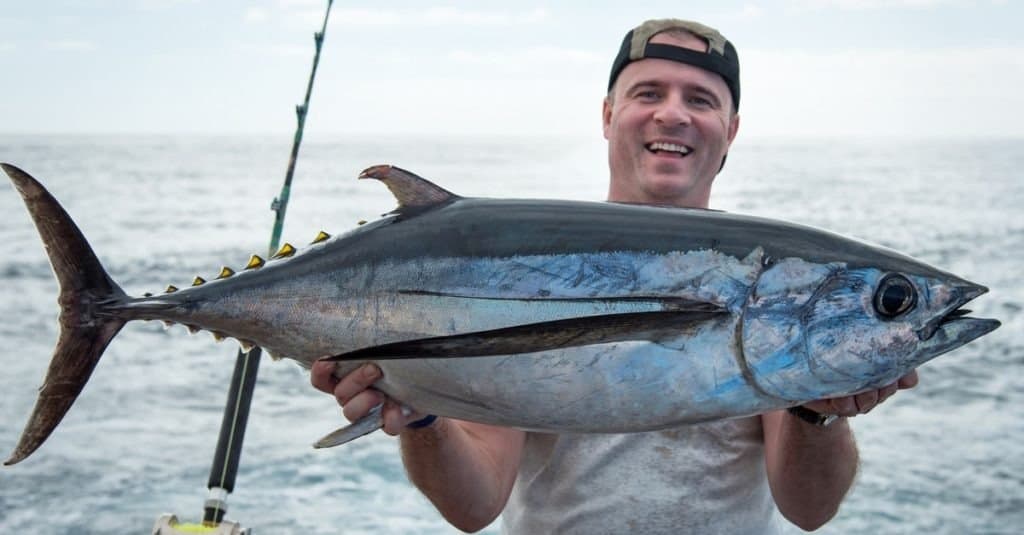Tuna
.jumbotron {
background-image: url(“https://a-z-animals.com/media/2021/01/Tuna-with-small-fish-400×300.jpg”);
}
}
@media only screen and (min-width: 641px) and (max-width: 920px) {
.jumbotron {
background-image: url(“https://a-z-animals.com/media/2021/01/Tuna-with-small-fish-470×370.jpg”);
}
}
@media only screen and (min-width: 921px) {
.jumbotron {
background-image: url(“https://a-z-animals.com/media/2021/01/Tuna-with-small-fish.jpg”);
}
}
Tuna
The tuna has a sleek body that enables it to swim quickly through the water
Tuna Scientific Classification
Read our Complete Guide to Classification of Animals.
Tuna Conservation Status
Tuna Facts
- Prey
- Fish, crustaceans, cephalopods, and mollusks
- Group Behavior
-
- School
- Fun Fact
- The tuna has a sleek body that enables it to swim quickly through the water
- Estimated Population Size
- Millions
- Biggest Threat
- Overfishing
- Most Distinctive Feature
- The metallic blue, silvery color
- Other Name(s)
- Tunny
- Gestation Period
- A few days
- Habitat
- Oceans
- Predators
- Sharks, humans, whales
- Diet
- Omnivore
- Type
- Ray-finned fish
- Common Name
- Tuna
- Number Of Species
- 15
This post may contain affiliate links to our partners like Chewy, Amazon, and others. Purchasing through these helps us further the A-Z Animals mission to educate about the world’s species..

Spiders that fly! Fish that walk! And 1000+ more incredible animals. Discover them all for FREE
.photo-gallery {
–margin: 0px auto 0px;
–padding: 0px 0px 0px 0px;
}
.gallery-link {
background-image: url(“https://a-z-animals.com/media/2021/01/Tuna-with-small-fish-1024×535.jpg”);
background-repeat: no-repeat;
background-size: cover;
background-position: center;
height: 500px;
justify-content: center;
text-align: center;
align-items: center;
display: flex;
border: 2px solid #000;
}
.gallery-link img {
height: 50%;
}
@media only screen and (max-width: 768px) {
.gallery-link {
height: 300px !important;
}
}
Beloved by millions of people as a culinary delight for its rich, succulent taste, the mighty tuna fish roams the world’s oceans.
Its sleek, streamlined torpedo-shaped body makes it one of the fastest fish in the world and a rather capable predator. The tuna fish is also a critical part of the world’s food supply, which has made it susceptible to overfishing.
3 Incredible Tuna Facts!
- The tuna fish is a migratory species that has no established home range. Some species travel thousands of miles per year.
- The tuna fish has a vast network of blood vessels in its body that always keeps the body temperature above the temperature of the surrounding water.
- The fish can swim at speeds of more than 40 mph.
Tuna Classification and Scientific Name
The scientific name of these fish is Thunnini. This seems to derive from the Ancient Greek word for tunny fish, which in turn means to run or dart along. Thunnini is actually an example of the taxonomical classification known as a tribe, which is situated between family and genus.
The 15 Different Type of Tuna
There are some 15 species of Thunnini in the world. Most of these species belong to the genus Thunnus, the “true tuna.” The skipjack belongs to its own genus, Katsuwonus.
- Skipjack Tuna: Although the skipjack isn’t among the true tuna species, it nevertheless has many of the hallmarks of these fish, including the same body shape, color, and appearance. As the smallest of the commercially fished species, it actually makes up much of the worldwide tuna catch.
- Yellowfin Tuna: As the name implies, this species is covered in yellow fins, including a set of particularly long dorsal and anal fins that curve back almost to the tail.
- Bluefin Tuna: The largest species by size, the bluefin is divided into a few different species, including the southern bluefin, Pacific bluefin, and Atlantic bluefin.
- Albacore Tuna: Slightly larger than the skipjack, the albacore has very long pectoral side fins that reach almost the entire length of the body.
Tuna Appearance
A true spectacle in the water, this is one of the largest fishes in the world. The bluefin can grow up to an enormous 2,000 pounds (the world record for a caught fish is 1,500), but realistically most species almost never grow larger than 500 pounds. The fish is characterized by a long torpedo-shaped body tapering off to a forked or crescent tail. Most of the body is covered in smooth, shiny blue or silver metallic skin with scales adorning only certain segments. It also has small “finlets” leading up to the tail that look like little spikes.

Piotr Wawrzyniuk/Shutterstock.com
Tuna Distribution, Population, and Habitat
These fish shows a preference for tropical and temperate waters all over the Atlantic, Pacific, and Indian Oceans. It occupies the pelagic zone, meaning all open oceans besides the coastline and bottom layer.
Although exact population numbers are not known, the oceans teem with millions of these fish. The annual catch is carefully managed by conservation organizations to prevent overfishing, but because of its migratory nature, this requires international cooperation.
Tuna Predators and Prey
These fish are among the top predators in the ecosystem. It keeps prey populations in check while providing an abundant meal for the few predators that do feed on it.
What does the tuna eat?
These fish feed on all manner of shellfish, squid, and many species of perciform fish. The juvenile fish also consume plankton during the first crucial stage of life.
For a full analysis on the diet’s of tuna fish, make sure to read ‘What Do Tuna Eat? Their Diet Explained.‘
What eats the tuna?
Due to its size, only the largest predators feed on adult fish, including some species of shark and whales. Seabirds and other fish species also consume the juveniles.
Tuna Reproduction and Lifespan
These fish are prolific breeders that can produce millions of eggs per year. Fertilized right in the water column of the open ocean, the eggs hatch after only a few days, although actual development to adulthood can take years. The tuna is relatively long-lived for a fish. While the yellowfin tuna only lives about seven years, some bluefin species can live up to 40 years in the wild.
Tuna in Fishing and Cooking
These fish are a cornerstone of many people’s diets and one of the most popular commercial and recreational fishes in the world. Some 4.9 million tons of tuna were caught in 2016, most of which were skipjack. This heavy reliance has led to plenty of over-exploitation. According to the International Seafood Sustainability Foundation, 13% of all tuna stocks are overfished worldwide.
Unlike the white meat of most fish, the tuna has a pink or dark red flesh thanks to the abundant quantity of oxygen-rich blood. Most of this tuna is canned light meat, but the higher quality meat can be served as sushi, sashimi, steaks, or any other fish recipe. It’s also popular in sandwiches, salads, wraps, and grilled dishes. Regardless of the recipe, this fish is abundant in nutrition such as vitamins and good fats.
View all 74 animals that start with T
Tuna FAQs (Frequently Asked Questions)
Can dogs eat tuna?
According to the American Kennel Club, dogs may not be able to handle the tuna’s high mercury levels over the long run. However, you also shouldn’t worry too much if the dog sneaks off a bit of tuna since small amounts won’t do any harm.
Is tuna fish good for you?
Tuna contains an abundance of omega-3 fatty acids, which are believed to be good for heart health and cholesterol levels. However, mercury levels can accumulate in long-lived oceanic fish and then pass to humans. That is why many health organizations recommend limiting consumption of this fish. Bigeye tuna tends to have the highest mercury levels, while skipjack has the least. It’s best to limit your consumption to one to three servings per week.
Why is tuna so cheap?
If it has a cheap price, then it’s probably skipjack or albacore, the most common stocks.
Which type of tuna is most expensive?
Bluefin tends to be the most expensive tuna due to declining stocks and the desirability of its meat.
How many types of tuna are there?
There are some 15 species of tuna, but only skipjack, yellowfin, bigeye, and albacore are caught in large quantities. Bluefin only accounts for 1% of the global catch.
What is the estimated population size of Tunas?
There are millions of Tunas.
What are some distinguishing features of the Tuna?
The Tuna has a metallic blue, silvery coloration.
What is another name for the Tuna?
The Tuna is also called the tunny.
What is an interesting fact about the Tuna?
The tuna has a sleek body that enables it to swim quickly through the water.
How fast is a Tuna?
A Tuna can travel at speeds of up to 50 miles per hour.
How do Tunas have babies?
Tunas lay eggs.
What’s the difference between tuna and albacore?
Albacore is a type of tuna fish, but not all tuna fish is albacore. Read more about their specific differences here.
What are the key differences between a tuna and an escolar?
The key differences between a tuna and an escolar are appearance, health effects, and culinary uses.
Sources
- Britannica, Available here: https://www.britannica.com/animal/tuna-fish
- WWF, Available here: https://www.worldwildlife.org/species/tuna
- ISSF, Available here: https://iss-foundation.org/state-of-tuna-stocks-worldwide-assessed-in-comprehensive-issf-report-2
















